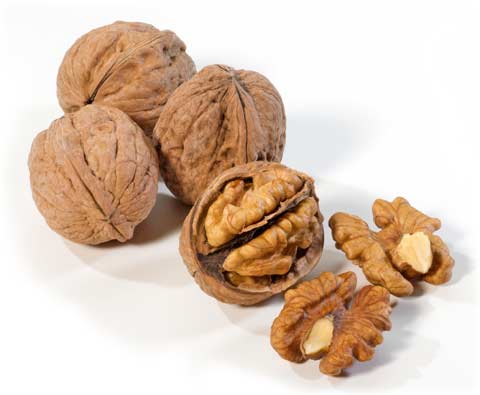Cancer Fighting Effects of Walnuts
- History of Walnuts
- Nutrients
- Lowers Risk of Cancer
- Anticancer Effects
- Buying, Storing, and Growing Walnuts

Fun Facts
Did you know that dark brown ink can be made from boiling the whole fruit? Walnut oil is also used in paints, soaps, and wood polish, while dyes are made from the shells for both hair and fabric. (i.211)
Ground walnut shells are sometimes added to soaps as an exfoliant. They also have many industrial uses — from dynamite filler to antiskid tires, and even as a cleaner for jet engines! (i.211)
According to some scientific estimates, about a third of all cancer-related deaths are linked to diet — with smoking tobacco the only lifestyle element representing a greater risk factor for the disease. Which foods represent clear risk factors and which are not is complex and often muddled with seemingly contradictory research evidence from literally thousands of studies. Despite the lack of clarity, however, the differences in cancer rates around the world suggest that diet may indeed be an important factor. Studies indicate that this may be more related to obesity and how certain foods contribute to this condition. (i.208, 209)
Nuts Are Full of Healthy Fats and Nutrients
For example, one of the most common food components that people associate with increased cancer risk is dietary fat, which may lead some people to avoid eating nuts because of their high fat content. By this standard, the high-fat Mediterranean diet could be considered a risk factor for cancer. However, although not conclusive, evidence suggests that while some types of fats are harmful if consumed in large amounts others may help prevent development or progression of the disease — including fats found in nuts. (i.209)
Nuts have many other important nutrients, such as natural hormones (e.g., melatonin), protein, fiber, and beneficial phytochemicals that contribute to maintaining good health. Walnuts, according to some scientists, are amongst the healthiest of all nuts because of their high antioxidant free-radical fighting content. In fact, walnuts have more antioxidants per 100 grams (a cup of shelled walnuts) than in some perhaps better-known sources, including blueberries, blackberries, and dark chocolate. At the end of the day foods high in quality antioxidants, beneficial polyphenols, and nutrients are known to protect cells from the ravages of aging, genetics, poor diet, stress, and other chronic diseases that simply wear out our cell defenses and increase risk of cancer. (i.209-213)
Walnuts Are Particularly Beneficial Nuts
Many nuts are rich in plant polyphenols that have potent antioxidant properties, such as flavonoids and ellagitannins. According to a report from Pennsylvania researchers that analyzed and compared nine types of nuts, walnuts contain twice the amount of higher quality antioxidants found in others. The study also determined that the antioxidants found in walnuts are more potent and of higher quality than those found in the other nuts, which included almonds, peanuts, pecans, and pistachios. (i.210, 214)
A Little Bit of Walnut History
Walnuts are among the Juglandaceae family of tree nuts, which includes almonds, Brazil nuts, hazelnuts, cashews, chestnuts, macadamia nuts, pine nuts, pecans, and pistachios. The fruit of the deciduous walnut tree is a green fleshy outer drupe containing a single hard-shelled seed. The walnut kernel appears as two off-white, bumpy lobes that are covered by a thin skin of a light brown color called a pellicle. A hard brown shell (which is either oblong or round) encloses the lobes. (i.211, 214, 215)
Although there many different varieties of walnuts, the three most commonly used for food are the English, black, and white types. English, or Persian, walnut is most commonly reported to have originated in areas surrounding the Caspian Sea and was spread throughout Europe by the ancient Romans. However, fossilized nuts of J. regia have been located in southern Germany from before the Roman Empire and in Hebei, China a 7,300 year old walnut shell fossil was found, while pollen was found in two bogs in Kashmir, India at a depth believed to date it between 10,000 and 17,000 years ago. Both black and white walnut trees are indigenous native species in the Appalachian and central Mississippi valley areas of North America. All types are powerhouses of antioxidant and anti-inflammatory nutrients and plant phytonutrients, and experts recommend consuming different types for maximum nutritional benefit. (i.211, 214, 216)
Nutrient Content in Walnuts
Walnuts contain high levels of omega-3 fatty acids (e.g., alpha linolenic acid and linoleic acid), which have many health benefits. In addition to being rich in antioxidants, these nuts provide plenty of manganese and copper. They also contain a variety of other minerals, including: (i.211, 215, 217)
- Calcium
- Chromium
- Cobalt
- Iron
- Magnesium
- Molybdenum
- Nickel
- Phosphorus
- Potassium
- Selenium
- Vanadium
- Zinc
Walnuts contain a high concentration of gamma-tocopherol, a particularly beneficial but non-typical form of vitamin E. Other vitamins and nutrients (including amino acids) in raw walnut meat include: (i.211, 215, 218)
|
|
|
Other useful compounds are tannins, flavonoids, phytosterols, and over a dozen phenolic acids — most of which is in the mildly bitter-tasting outer skin. In particular, walnuts contain water-soluble ellagitannins that transform into ellagic acid. Studies suggest ellagic acid can help protect against colon, esophageal, and lung cancer. (i.211, 215, 219)
Walnuts Can Help Prevent Chronic Disease Risk Factors for Cancer
The many beneficial nutrients and phytochemicals in walnuts possess antioxidant and anti-inflammatory properties that are natural cancer fighters. Despite the high-fat content of walnuts, results of lab, animal, and human studies indicate that incorporating walnuts into a healthy diet may help lower the risks of many chronic health conditions that contribute to a higher cancer risk — including obesity, heart disease, and insulin resistance. (i.155, 213)
Metabolic Syndrome
These chronic inflammatory conditions (along with high cholesterol and hypertension) are part of what the medical community refers to as metabolic syndrome. Individually and together they have been associated with higher risks of developing cancer, especially breast, colon, and esophageal cancer. Metabolic syndrome also promotes tumor progression and is associated with reduced survival rates. Prospective population studies show that having more than one of the underlying syndrome conditions raises the risk even more. (i.154, 155)
Potential Help for Insulin Control and Weight Loss
Analysis of results from human clinical studies involving overweight and obese patients suggests that walnuts can increase feelings of fullness and raise metabolic rates. Although older study results showed no effect from walnuts on blood sugar control, they did when accompanied by other dietary changes. In that clinical trial, including walnuts in an otherwise low-fat diet in overweight diabetics (type-2) resulted in significantly lower fasting blood sugar levels. These patients also lost 2.2-4.4 lbs. of weight as an unintended outcome of the 3-month study. (i.213)
Some experts suggest that the beneficial effects of walnuts may only be noticeable when incorporated in a diet designed for weight loss may improve cholesterol, glucose, and insulin levels. However, regular diets containing nuts (including walnuts) may reduce the overall risk of developing metabolic syndrome and associated increased risk of cancer. In a one-year randomized clinical trial, people who consumed nuts had a 14% reduction in rates of metabolic syndrome — far better than the 2% reduction found in those on a low-fat diet, or even the 7% reduction found in those on the olive-oil rich Mediterranean diet. Extracts from walnut leaves have also produced dramatic and even permanent reductions in postprandial blood sugar levels in separate animal studies. (i.155, 209, 213, 220)
Evidence of Walnut’s Anticancer Effects
Research in animals suggests that dietary walnuts may help to inhibit the growth of colorectal cancer tumors. Studies conducted on mice showed that those fed diets that included walnuts slowed tumor growth and reduced tumor size by a third compared to the control group. Walnuts appeared to suppress factors that inhibited growth of blood vessels to feed the tumors, not only stunting their growth but also resulted in larger areas of dead cancer cells in the tumors. (i.221)
Results of another animal study suggested that eating walnuts may help to prevent the development and slow the growth of breast cancer. According to the lead researcher, this is mainly due to the phytosterols the nuts contain, as well as antioxidants and omega-3 fatty acids. Estrogen speeds up the growth of breast cancer; hence the tendency of phytosterols to bind to the estrogen receptors helps to check the spread of the disease. However, other experts caution there is still need for further studies, considering that the experiments were performed on mice. (i.222)
The combination of components such as minerals, alpha linolenic acid, proteins, vitamin E, and trace nutrients in walnuts may also be beneficial against prostate cancer. Animal studies show that walnuts can help significantly slow down the initial growth rates of prostate cancer tumors stimulated by high fat diets. The researchers at UCLA funded by California's Walnut Board also used gene-chip technology to compare the difference between the effects of the soybean oil or walnut high-fat diets, and found that walnuts reduced activity of at least one growth factor gene. And in an 8-week clinical trial, men who took walnut supplements showed improvements in indicators for prostate health in blood tests. (i.211, 223)
Adding Walnuts to Your Diet
Although walnuts may be eaten raw or roasted and added to a number of cooked and baked dishes, it is always advisable to include the whitish, flaky outer skin, which contains about 90% of phenols in the nuts. (i.215)
Some suggestions: (i.1, 212, 215)
- Toasting shelled at 350° for 10 minutes still retains most nutrients in walnuts.
- Toss raw, roughly chopped walnuts in a fresh salad.
- Blend raw or toasted walnuts with yogurt and your favorite fruit for a smoothie.
Some unusual uses include: (i.211)
- Pickled (unripe green walnuts).
- Pressed walnut oil (used in dressings, for cooking, and as a food flavoring).
- Nocino and Nocello, Italian walnut-flavored liqueurs.
- Agnolotti pasta stuffing (made from finely ground walnut shells).
- Tea (made from dried walnut tree leaves).
Buying and Storing Walnuts
Try to purchase unshelled nuts and avoid shelling until you are ready to use or eat since studies show they contain significantly more antioxidants than those stored without shells. Select walnuts that feel rather heavy for their size and look for those that do not rattle around in the shell when you shake them. Throw out or skip any with damaged shells as this can indicate the development of unsafe mold on the nut itself. Avoid shriveled or rancid (sour or musty smelling) walnuts. (i.1, 214, 215)
The nuts perish fast because of their high levels of polyunsaturated fat and the shelled ones should be kept in airtight containers stored in the refrigerator or freezer 6-12 months, respectively, but shorter times are better in terms of freshness). Although unshelled walnuts may be stored in any dark, dry and cool place, keep them in a refrigerator if possible for even longer storage times. (i.1, 215)
Growing Walnuts
Walnut trees require moist and fertile soil with good drainage. Plant yearling trees for best results, and allow for a depth of at least 30 inches of unobstructed soil for the roots to grow in--avoiding anything that may interfere with root development. The nuts require at least 140 frost-free days and precipitation of 25 inches per year, with the optimum levels being 170+ days and 35+ inches respectively. They do poorly under shade so be sure to not plant too densely and thin out stands of walnut trees when crowns begin to overlap. (i.224)



